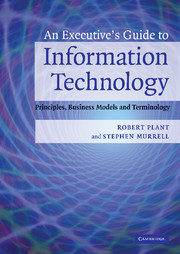Book contents
- Frontmatter
- Contents
- Introduction
- A ACM (Association for Computing Machinery) to Audio
- B Backup to Business process re-engineering
- C C, C++, C# to Cracking
- D Database to Dynamic web pages
- E e-Commerce/e-business to European Union Directive on Privacy and Electronic Commerce 2002
- F Fiber optics to Fuzzy logic
- G to H Global positioning system to Hypertext, HTML
- I ICANN (Internet Corporation for Assigned Names and Numbers) to ISP (Internet service provider)
- J to L Java to Logic programming
- M Machine learning to Multicast
- N Natural language processing (NLP) to Normalization
- O Object-oriented to Outsourcing
- P Packet switching and circuit switching to Public key-private key
- Q to R Quantum computing to RSS (Really simple syndication)
- S Sarbanes-Oxley Act of 2002 (SOX) to Structured design methodologies
- T to U T-Carrier to URL (Uniform resource locator)
- V Value added network (VAN) to Voice over IP (VoIP)
- W W3C (the World Wide Web Consortium) to WYSIWYG
- X to Z X.12 to Zip
- Index
- References
F - Fiber optics to Fuzzy logic
Published online by Cambridge University Press: 17 May 2010
- Frontmatter
- Contents
- Introduction
- A ACM (Association for Computing Machinery) to Audio
- B Backup to Business process re-engineering
- C C, C++, C# to Cracking
- D Database to Dynamic web pages
- E e-Commerce/e-business to European Union Directive on Privacy and Electronic Commerce 2002
- F Fiber optics to Fuzzy logic
- G to H Global positioning system to Hypertext, HTML
- I ICANN (Internet Corporation for Assigned Names and Numbers) to ISP (Internet service provider)
- J to L Java to Logic programming
- M Machine learning to Multicast
- N Natural language processing (NLP) to Normalization
- O Object-oriented to Outsourcing
- P Packet switching and circuit switching to Public key-private key
- Q to R Quantum computing to RSS (Really simple syndication)
- S Sarbanes-Oxley Act of 2002 (SOX) to Structured design methodologies
- T to U T-Carrier to URL (Uniform resource locator)
- V Value added network (VAN) to Voice over IP (VoIP)
- W W3C (the World Wide Web Consortium) to WYSIWYG
- X to Z X.12 to Zip
- Index
- References
Summary
Foundation concept: Cables and connectors.
Definition: Data encoded as pulses of light conducted along flexible transparent wires as a replacement for data sent as electrical pulses along a flexible metal wire.
Overview
The most familiar means for transmitting signals or data is by sending electrical impulses along a flexible metal (nearly always copper) wire. This has many advantages: electrical signals are the native internal infrastructure of all computing devices, so very little signal conversion is required; wires can easily be insulated to prevent cross-over with other signals; electronic signals travel along wire at the speed of light, so speed is maximized. There is also one major disadvantage: when electric currents pass through metal wires they generate magnetic fields, and when metal wires pass through varying magnetic fields, they pick up induced electric currents. This means that, whenever two signal wires run close together, they will interfere with each other, and whenever a wire passes near to any electronic device, it will pick up interference from it. Heavy-duty electro-mechanical devices, such as large electric motors, can easily generate enough interference to swamp any real signal, and even enough to damage connected electronic equipment.
Common alternatives, such as transmitting signals by radio or microwave, suffer from similar problems. Radio and microwave signals can not be insulated and can not be channeled along a “wire,” so multiple signals have to use significantly different wavelengths in order to avoid complete interference; electrically generated interference is still a problem for radio, and microwave signals need a straight “line-of-sight” unobstructed path to follow; and there may be significant environmental dangers associated with some wireless signals (there is some controversy, but microwave radiation in the environment is a major concern for many).
- Type
- Chapter
- Information
- An Executive's Guide to Information TechnologyPrinciples, Business Models, and Terminology, pp. 143 - 162Publisher: Cambridge University PressPrint publication year: 2007



